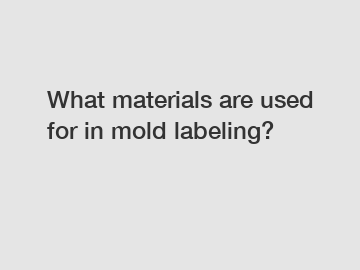What materials are used for in mold labeling?
If you've ever wondered what materials are used for in-mold labeling, you've come to the right place. In-mold labeling, also known as IML, is a process where labels are placed inside a mold before injection molding. This allows for the label to become an integral part of the final product, resulting in a seamless and durable finish. Let's take a closer look at the materials used for in-mold labeling.
Types of materials.
1. Polypropylene (PP): Polypropylene is a commonly used material for in-mold labeling due to its versatility and durability. It is resistant to moisture, chemicals, and heat, making it an ideal choice for a wide range of applications.

2. Polyethylene (PE): Polyethylene is another popular material for in-mold labeling. It is known for its flexibility and ease of use, making it a cost-effective option for many manufacturers.
3. Polyvinyl chloride (PVC): PVC is a widely used material for in-mold labeling, thanks to its outstanding printability and high impact resistance. It is commonly used in applications where a vibrant, high-quality finish is required.
4. Polystyrene (PS): Polystyrene is a versatile material that is often used for in-mold labeling. It is lightweight and easy to work with, making it a popular choice for a variety of products.
5. Polyester (PET): Polyester is a durable and heat-resistant material that is commonly used for in-mold labeling. It offers excellent clarity and is great for products that require a high level of transparency.
Choosing the right material.
When selecting a material for in-mold labeling, it's important to consider the specific requirements of your product. Factors to keep in mind include the type of product, the environment it will be used in, and any special considerations such as heat or chemical resistance. Your supplier can help you choose the right material for your specific needs.
Benefits of in-mold labeling.
In-mold labeling offers numerous benefits for manufacturers, including:
- Increased durability: In-mold labels become an integral part of the final product, making them more resistant to wear and tear.
- Cost savings: In-mold labeling reduces the need for secondary labeling processes, saving time and money.
- Enhanced aesthetics: In-mold labels offer a seamless and high-quality finish, enhancing the overall appearance of the product.
In conclusion, the materials used for in-mold labeling play a crucial role in the success of the final product. By choosing the right material for your specific requirements, you can ensure a seamless and durable finish that meets the needs of your customers. If you have any questions about in-mold labeling or would like to learn more about our services, please contact us. Our experienced team of experts is here to help you find the perfect solution for your labeling needs.
For more 500ml Ice Cream Tubs Manufacturer, Injection Molding IML, 80ml IML Plastic yogurt cup packaginginformation, please contact us. We will provide professional answers.
123
0
0


Comments
All Comments (0)